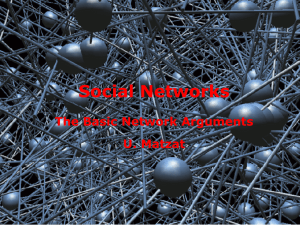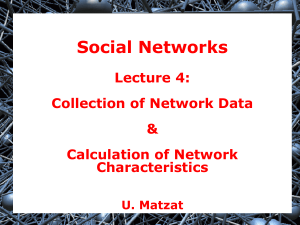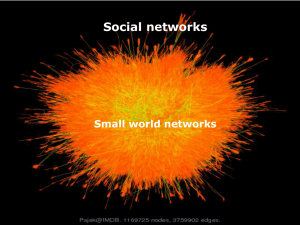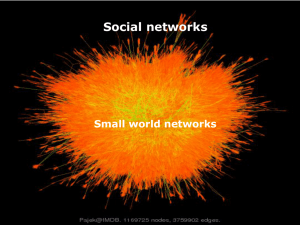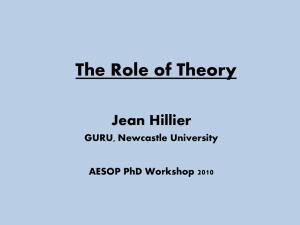slides - Chrissnijders
advertisement
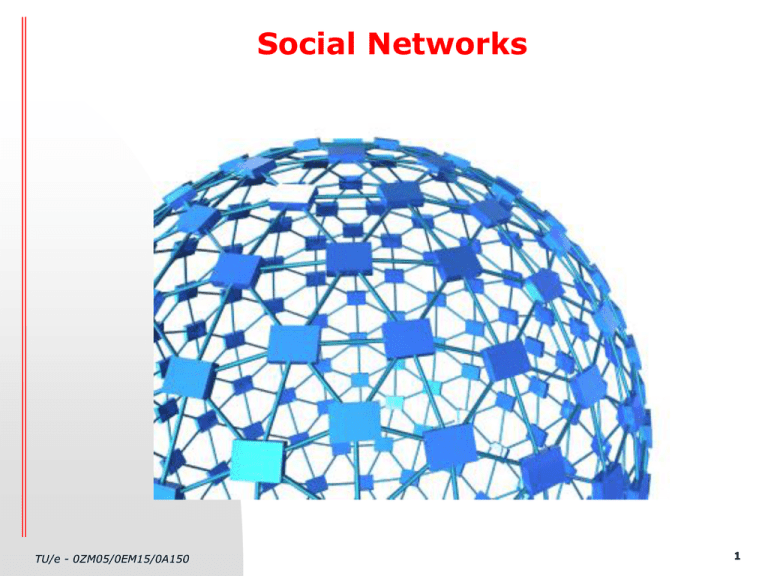
Social Networks TU/e - 0ZM05/0EM15/0A150 1 Obesity as a networked concept TU/e - 0ZM05/0EM15/0A150 2 TU/e - 0ZM05/0EM15/0A150 3 The same goes for smoking … TU/e - 0ZM05/0EM15/0A150 4 www.tue-tm.org/INAM All course info, literature, slides, and messages can be found here. Check regularly! TU/e - 0ZM05/0EM15/0A150 5 Today Course design and content Introduction to network analysis and concepts TU/e - 0ZM05/0EM15/0A150 6 Lecturers Chris Snijders c.c.p.snijders@gmail.com Uwe Matzat u.matzat@tue.nl Rudi Bekkers r.n.a.bekkers@tue.nl Mila Davids m.davids@tue.nl Gerrit Rooks g.rooks@tue.nl TU/e - 0ZM05/0EM15/0A150 7 The course: organization Three courses: 0ZM05 (5 ects) 0EM15 (6 ects) 0A150 (3 ects) Lectures every week on Wednesdays, hours 7 and 8. Later in the program less lecture time, more "assignment time" (see the course website). Different courses, so not everybody has to do the same ... TU/e - 0ZM05/0EM15/0A150 8 Rough outline for the different courses (see online for the details) Topic 0em15 0zm05 0a150 Basic stuff (about 5 lectures) Yes Yes Yes Assignment CS Yes Yes Yes Assignment UM Yes Yes No Personal and business networks + assignment GR No No Yes Dynamic capabilities and knowledge transfer in networks Yes No No Exam Yes Yes No (have to be there) + survey completion (so that you experience what a network survey feels like, and we can analyze the data during class and assignments) TU/e - 0ZM05/0EM15/0A150 9 TU/e - 0ZM05/0EM15/0A150 10 Course requirements 0em15/0zm05: Two (group of 2) assignments + written exam. Grade = 50% assignments + 50% exam. Both assignments and the exam should be at least a 4.0. Final grade should be at least 5.5. For 0a150 it’s the average of the two assignments, where both should be at least 4.0 and the average at least 5.5 TU/e - 0ZM05/0EM15/0A150 11 To do: register in Studyweb (if possible) TU/e - 0ZM05/0EM15/0A150 12 TU/e - 0ZM05/0EM15/0A150 13 Course aim knowledge about concepts in network theory, and being able to apply that knowledge (with an emphasis on innovation and alliances) TU/e - 0ZM05/0EM15/0A150 14 The setup in some more detail Network theory and background - - Introduction: what are they, why important … Four basic network arguments Kinds of network data (collection) Typical network concepts Visualization and analysis TU/e - 0ZM05/0EM15/0A150 15 Some historical background and a general intro TU/e - 0ZM05/0EM15/0A150 16 It’s about making our 'social space' visible "If we ever get to the point of charting a whole city or a whole nation, we would have … a picture of a vast solar system of intangible structures, powerfully influencing conduct, as gravitation does in space. Such an invisible structure underlies society and has its influence in determining the conduct of society as a whole." Jacob L. Moreno New York Times, April 13, 1933 TU/e - 0ZM05/0EM15/0A150 17 We live in a connected world “To speak of social life is to speak of the association between people – their associating in work and in play, in love and in war, to trade or to worship, to help or to hinder. It is in the social relations men establish that their interests find expression and their desires become realized.” Peter M. Blau Exchange and Power in Social Life, 1964 TU/e - 0ZM05/0EM15/0A150 18 Why do networks matter? TU/e - 0ZM05/0EM15/0A150 19 Why do networks matter? TU/e - 0ZM05/0EM15/0A150 20 Social Networks – a (cheesy) introduction http://www.youtube.com/w atch?v=6a_KF7TYKVc TU/e - 0ZM05/0EM15/0A150 21 Social network analysis – it's core An interdisciplinary perspective emphasizing structural relationships as key explanatory concepts and principles: • Structural properties of social formations are contexts that shape the perceptions, beliefs, attitudes, and actions of individuals and collectivities • Social influence and collective action may be facilitated and/or constrained by direct and indirect exchanges (transactions) among social actors possessing differential resources (e.g., information) • Actors and transactions/interactions between actors are embedded, i.e. located within actual situational contexts TU/e - 0ZM05/0EM15/0A150 22 The network perspective Two firms in the same market. Which firm performs better (say, is more innovative): A or B? A B This depends on: •Cost effectiveness •Organizational structure •Corporate culture •Flexibility •Supply chain management •… TU/e - 0ZM05/0EM15/0A150 23 The network perspective Two firms in the same market. Which firm performs better (say, is more innovative): A or B? A B Note and ... on the structure of the network TU/e - 0ZM05/0EM15/0A150 Networks are one way of dealing with “market imperfection” 24 Multi-level and interdisciplinary Network applications appear in diverse substantive fields of mostly social sciences – anthropology, management, political science, public health, sociology (and recently also in economics) Studies span micro- meso- & macro-levels of analysis: • personal social & health support systems • children’s play groups, high school cliques • employee performance • neighboring behavior, community participation • work teams, voluntary associations, social movements • military combat platoons, terrorist cells • corporate strategic alliances, board interlocks • international relations: trade, aid, war & peace •Internet relations: Twitter, LinkedIn, Facebook TU/e - 0ZM05/0EM15/0A150 25 It's a science ... TU/e - 0ZM05/0EM15/0A150 26 Example: crime research Example topics -"Cold case" research - forensic psychiatry -(youth) crime -... TU/e - 0ZM05/0EM15/0A150 27 Articles with Network* Keyword 5000 4000 3000 SocAbs 2000 EconLit 1000 0 1965-70 1970-75 1975-80 1980-84 1985-89 YEAR 4/13/2015 SOURCES: Sociological Abstracts, EconLit 1990-94 1995-99 2000-04 Network analysis: origins Started in 1920s, Jacob L. Moreno pioneered social network analysis for his “psychodrama” therapy. He used sociomatrices and hand-drawn sociograms to display children’s likes and dislikes of classmates as directed graphs (digraphs). TU/e - 0ZM05/0EM15/0A150 29 Moreno’s socio-matrix TU/e - 0ZM05/0EM15/0A150 30 … displayed as a sociogram TU/e - 0ZM05/0EM15/0A150 31 Example: A targeted approach to HIV prevention Think about similar examples for: • Introduction of new products into target groups •… TU/e - 0ZM05/0EM15/0A150 32 Modern computing makes a big difference “Visualization has been a key component of social network analyses from the beginning, proliferating into today’s dazzling computer-based multidimensional displays” (Freeman 2001) TU/e - 0ZM05/0EM15/0A150 33 Social network software 1) UCINet – Many things on network analysis Lin Freeman, Steve Borgatti, Martin Everett 2) MultiNet – Whole Network Analysis + Nodal Characteristics 3) P*Star – Dyadic Analysis – Stan Wasserman 4) NodeXL (an Excel plugin) – Marc Smith 5) Pajek – Network Visualization – Supersedes Krackplot 6) 7) StocNet – Tom Snijders - collected programs for, e.g., analysis of dynamic networks … and many others NB Even though computers are fast, really large networks can still be a real problem TU/e - 0ZM05/0EM15/0A150 34 Definitions and other boring stuff TU/e - 0ZM05/0EM15/0A150 35 Social network basics A network (or graph) contains a set of actors (or nodes, objects, vertices), and a mapping of relations (or ties, or edges, connections) between the actors 1 2 For instance: Actors: persons Relationships: “participates in the same course as” Or: Actors: organizations Relationships: have formed an alliance TU/e - 0ZM05/0EM15/0A150 36 Social network concepts: ties Relationships can be directed: 1 2 For instance: person 1 likes person 2 Symmetrical by choice: 1 2 Person 1 likes 2, 2 likes 1 Symmetrical by definition: 1 2 Person 1 is married to 2 (usually depicted as) TU/e - 0ZM05/0EM15/0A150 1 2 37 Social network concepts: weights Relationships can carry weights : 1 2 3 4 Actors: persons Relationships: know each other 3 and 4 know each other better (stronger tie) Actors can have a variety of properties associated with them: TU/e - 0ZM05/0EM15/0A150 38 Social networks: translating arguments There is reciprocity: whenever there is a tie from a to b, there also is a tie from b back to a Actor A is powerful: many connections go through A 1 2 TU/e - 0ZM05/0EM15/0A150 3 39 Quantifying matters through network concepts Actor characteristics: outdegree indegree betweenness ... (and many more) Network characteristics density segmentation distribution of outdegrees ... (and many more) TU/e - 0ZM05/0EM15/0A150 40 More examples TU/e - 0ZM05/0EM15/0A150 41 An example of a modern network: 9-11 Hijackers Network SOURCE: Valdis Krebs http://www.orgnet.com/ TU/e - 0ZM05/0EM15/0A150 42 OECD Trade Flows 1981-1992 Note: practical use of visualization diminishes as networks grow larger SOURCE: Lothar Krempel TU/e - 0ZM05/0EM15/0A150 http://www.mpi-fg-koeln.mpg.de/~lk/netvis.html 43 Internet facilitates social networking… TU/e - 0ZM05/0EM15/0A150 44 … for recreational use … TU/e - 0ZM05/0EM15/0A150 45 … also for business purposes … http://www.youtube.com/watch?v=6SSR2tg5n_U TU/e - 0ZM05/0EM15/0A150 46 … or, if you want to create your own FaceBook-like site … http://www.vivalogo.com/vl-resources/opensource-social-networking-software.htm BTW Lots of businesses are willing to do the dirty work for you … TU/e - 0ZM05/0EM15/0A150 47 Organizations as networks: org-chart shows formal ties… SOURCE: Brandes, Raab and Wagner (2001) <http://www.inf.uni-konstanz.de/~brandes/publications/brw-envsd-01.pdf> TU/e - 0ZM05/0EM15/0A150 48 … but the graph of actual connections is really different TU/e - 0ZM05/0EM15/0A150 49 … and can be restructured to reveal the “real” hierarchy! TU/e - 0ZM05/0EM15/0A150 50 Networks and innovation TU/e - 0ZM05/0EM15/0A150 51 Why networks & innovation? Classic innovation studies focus mainly on characteristics of individuals or firms to explain innovation e.g. firm size and innovativeness However, innovation, is inherently social in nature e.g. firms have relations with other firms and consequently access to additional external resources Hence, networks of social relations between actors (individuals and organizations) may be important factors in explaining innovation and innovation may change networks of social relations as well TU/e - 0ZM05/0EM15/0A150 52 Why networks and alliance management? The knowledge economy is a network economy Third Industrial Revolution Second Industrial Revolution CEO Staff Divisions Guild Master Pupil Master Pupil Master Pupil Networked model: Economies of skill: -access to knowledge -co-development -leverage knowledge -focus on core competences -learn and innovate ‘Stand alone’ model: - Economies of scale - Optimize assets Organizational models are transforming from “stand alone” to “networked” TU/e - 0ZM05/0EM15/0A150 53 CEOs rate alliances among the most important management tools Bain researched the 25 most popular management tools in a survey among 960 international executives • Alliances are among the 10 most widely used tools by top executives • 63% of them use alliances • Note that other tools involve alliance and network related aspects as well: CRM, outsourcing, growth strategies, supply chain management Source: Rigby, 2005, Management Tools 2005, Bain & Company TU/e - 0ZM05/0EM15/0A150 54 Alliances lead to networks Network in Flat Screens 2000-2001 Source: De Man, 2006, Alliantiebesturing In 2 years time 75% of the firms in the industry are directly or indirectly connected TU/e - 0ZM05/0EM15/0A150 55 Network questions and arguments TU/e - 0ZM05/0EM15/0A150 57 Typicalities of network arguments Non-linear effects can occur easily (cf “Smallworld phenomenon”) in networks [lecture 3] Data collection often daunting = “is being eaten by” TU/e - 0ZM05/0EM15/0A150 58 TU/e - 0ZM05/0EM15/0A150 59 Typical network related questions Which of these actors has the best position in the network? Example: firms in alliance networks Which kinds of networks are best for <…> purposes? Example: R&D teams Which are the key relations in the network? Example: terrorism TU/e - 0ZM05/0EM15/0A150 60 Networks = Y or Networks = X In most social science applications, networks are considered as an independent variable. For instance Firm A performs better than B because firm A is embedded in a network with a lot of ties (a network of higher “density”) or Person A performs better than B because person A has a lot of ties to other persons and person B doesn’t (firm A has a higher “outdegree”) TU/e - 0ZM05/0EM15/0A150 61 Networks = Y or Networks = X Sometimes: networks as the dependent variable For instance: How do the social networks of successful people differ from the social networks of others? (and why is that?) And, even rarer: dynamic network theory For instance: How do the friendship networks of people change over time? TU/e - 0ZM05/0EM15/0A150 62 Using network arguments... Make sure that you define the actors/nodes, and what the ties between them represent (directed?, weighted?). Make clear how and what (kind of) network characteristics drive your result. There are so many network characteristics … think hard! Shop around for arguments in areas unrelated to your own! (where perhaps only the nodes and the ties are different!) “The best ideas already exist” TU/e - 0ZM05/0EM15/0A150 63 Kinds of network arguments (in detail next week) Closure competitive advantage stems from managing risk; closed networks enhance communication and enforcement of sanctions Brokerage competitive advantage stems from managing information access and control; networks that span structural holes provide the better opportunities Contagion information is not a clear guide to behavior, so observable behavior of others is taken as a signal of proper behavior. [1] contagion by cohesion: you imitate the behavior of those you are connected to [2] contagion by equivalence: you imitate the behavior of those others who are in a structurally equivalent position Prominence information is not a clear guide to behavior, so the prominence of an individual or group is taken as a signal of quality TU/e - 0ZM05/0EM15/0A150 64 To Do: follow the directions on www.tue-tm.org/INAM Studyweb: register! TU/e - 0ZM05/0EM15/0A150 65
